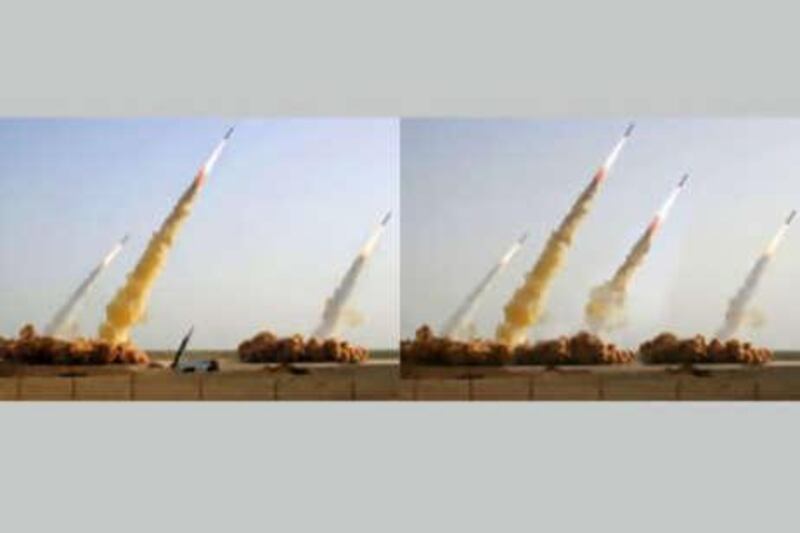Iran's televised display of missile firepower, accompanied by thunderous rhetoric, brought international condemnation and rattled oil markets, but did little to impress military analysts who said the muscle-flexing was not potent enough to deter any would-be attacker. Their reservations will be compounded by what appears to be a bit of sloppy propaganda from Iran's vaunted Revolutionary Guards. The first photo released on Wednesday by the Guards' media arm, Sepah News, showed four missiles shooting skyward in unison. The impressive image, picked up by an international news agency, made front pages around the world. Yesterday, however, Sepah published a version of the same image but with only three missiles - and no explanation for the discrepancy. Could it be one of its cherished missiles misfired and did Sepah doctor the photo to hide the mishap? Agence France-Presse, which obtained the original image from Sepah's website, withdrew the four-missile version yesterday morning, saying the image had apparently been "digitally altered" by Iranian state media. The fourth missile has "apparently been added in digital retouch to cover a grounded missile that may have failed during the test", the French news agency said. It is not a slip Iran would want to acknowledge to the United States or Israel or its people. The nine missiles fired were designed to prove the Islamic republic's ability to retaliate against attack - while protecting Iranians who may have been rattled by recent Israeli military exercises that were effectively practice runs for a potential strike against Iran's nuclear facilities. Iran appeared undeterred by the propaganda slip up, test-firing more missiles yesterday, even as Condoleezza Rice, the US secretary of state, warned that Washington had beefed up its security presence in the Gulf and would not hesitate to defend Israel and other allies in the region. Ms Rice said a planned US missile defence shield, to be partly based in the Czech Republic and Poland, would dampen any threat of an attack from Iran. "We also are able to look to the future of a missile defence system that will make it more difficult for Iran to threaten [and] and be bellicose and say terrible things because their missiles won't work," Ms Rice said. Few Iran observers would be surprised if the Iranian state media had tampered with the photo. Tehran has long been suspected of exaggerating its military capabilities. Iran boasted on Wednesday that among the nine missiles it test-fired was a "new version" of its Shahab-3 with a proclaimed range of 2,000km. A missile with such reach could strike Israel, Turkey, the Arabian peninsula, Afghanistan and Pakistan, encompassing an area where tens of thousands of American troops are stationed. But some analysts thought the images provided by Iran showed a Shahab missile - primarily based on North Korean technology and locally improved - that was several years old. Another military analyst, Paul Beaver, said Iran's missile programme was fairly advanced but still needed to get accuracy and guidance systems for long distances. "They are some way away yet from threatening Israel or US bases," he told Reuters. Iran's military claims it has thousands of missiles readied against predetermined targets, but does not give a breakdown. But Peter Wezeman, a researcher at the Stockholm International Peace Institute, said he did not believe Iran had many Shahab-3 missiles in stock or that they could cause major destruction: they were not that accurate and also carried a limited payload. "I don't think it is really going to impress Israel that much as long as they [Iranians] use conventional warheads," he said. Similarly, Iran has been accused of hyping its progress in uranium enrichment, a programme it insists is solely to generate electricity but which the West suspects is aimed at developing a weapons capability. "While deeply troubling, Iran's real nuclear progress has been less than the sum of its boasts," Nicholas Burns, a US undersecretary of state, said just hours after Iran's first missile tests on Wednesday. "It has not yet perfected [uranium] enrichment and, as a direct result of UN sanctions, Iran's ability to procure technology or items of significance to its missile programmes, even dual-use items, is being impaired." Tehran, however, may be more concerned by the news yesterday that Total said it would not invest in Iran because it is too politically risky. It was the last major western energy group to have considered seriously investing in Iran's huge gas reserves. Despite Sepah's apparent slip-up, some Iran watchers were impressed by the television footage of Iran's "Noble Prophet III" military exercises which came with a soundtrack blasting out rap music, with both religious and nationalistic motifs. One Iranian viewer, describing the production as a "postmodern pastiche" detected the work of "Hich-kas", an Iranian underground "gangsta rap" artist, and the London-based Iranian rapper, Reveal, although no attribution was made for the soundtrack. mtheodoulou@thenational.ae
Iran missile success in doubt
A photo showing Iran's controversial missile tests on Thursday appears to have been "digitally altered".

Editor's picks
More from the national




